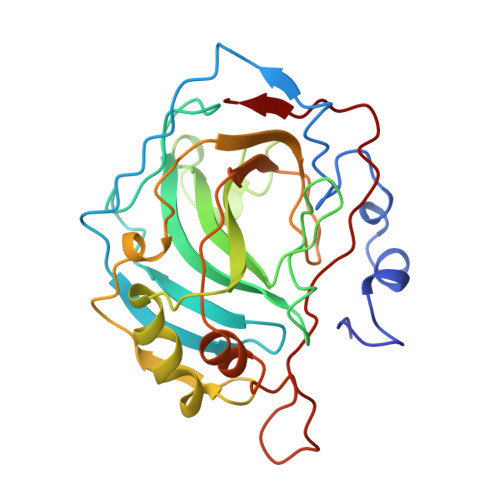Structural basis of inhibitor affinity to variants of human carbonic anhydrase II.
Nair, S.K., Krebs, J.F., Christianson, D.W., Fierke, C.A.(1995) Biochemistry 34: 3981-3989
- PubMed: 7696263
- DOI: https://doi.org/10.1021/bi00012a016
- Primary Citation of Related Structures:
1YDA, 1YDB, 1YDC, 1YDD - PubMed Abstract:
The activities and structures of certain L198 variants of human carbonic anhydrase II (CAII) have been reported recently [Krebs, J. F., Rana, F., Dluhy, R. A., & Fierke, C. A. (1993) Biochemistry 32, 4496-4505; Nair, S. K., & Christianson, D. W. (1993) Biochemistry 32, 4506-4514]. In order to understand the structural basis of enzyme-inhibitor affinity, we now report the dissociation rate and equilibrium constants for acetazolamide and dansylamide binding to 13 variants of CAII containing substituted amino acids at position 198. These data indicate that inhibitor affinity is modulated by the hydrophobicity and charge of the 198 side chain. Furthermore, we have determined crystal structures of L198R, L198E, and L198F CAIIs complexed with the transition state analog acetazolamide. The substituted benzyl side chain of L198F CAII does not occlude the substrate association pocket, and it is therefore not surprising that this substitution has minimal effects on catalytic properties and inhibitor binding. Nevertheless, the F198 side chain undergoes a significant conformation change in order to accommodate the binding of acetazolamide; the same behavior is observed for the engineered side chain of L198R CAII. In contrast, the engineered side chain of L198E CAII does not alter its conformation upon inhibitor binding. We conclude that the mobility and hydrophobicity or residue 198 side chains affect enzyme-inhibitor (and enzyme-substrate) affinity, and these structure-function relationships are important for understanding the behavior of carbonic anhydrase isozyme III, which bears a wild-type F198 side chain.(ABSTRACT TRUNCATED AT 250 WORDS)
Organizational Affiliation:
Department of Chemistry, University of Pennsylvania, Philadelphia 19104-6323.

















